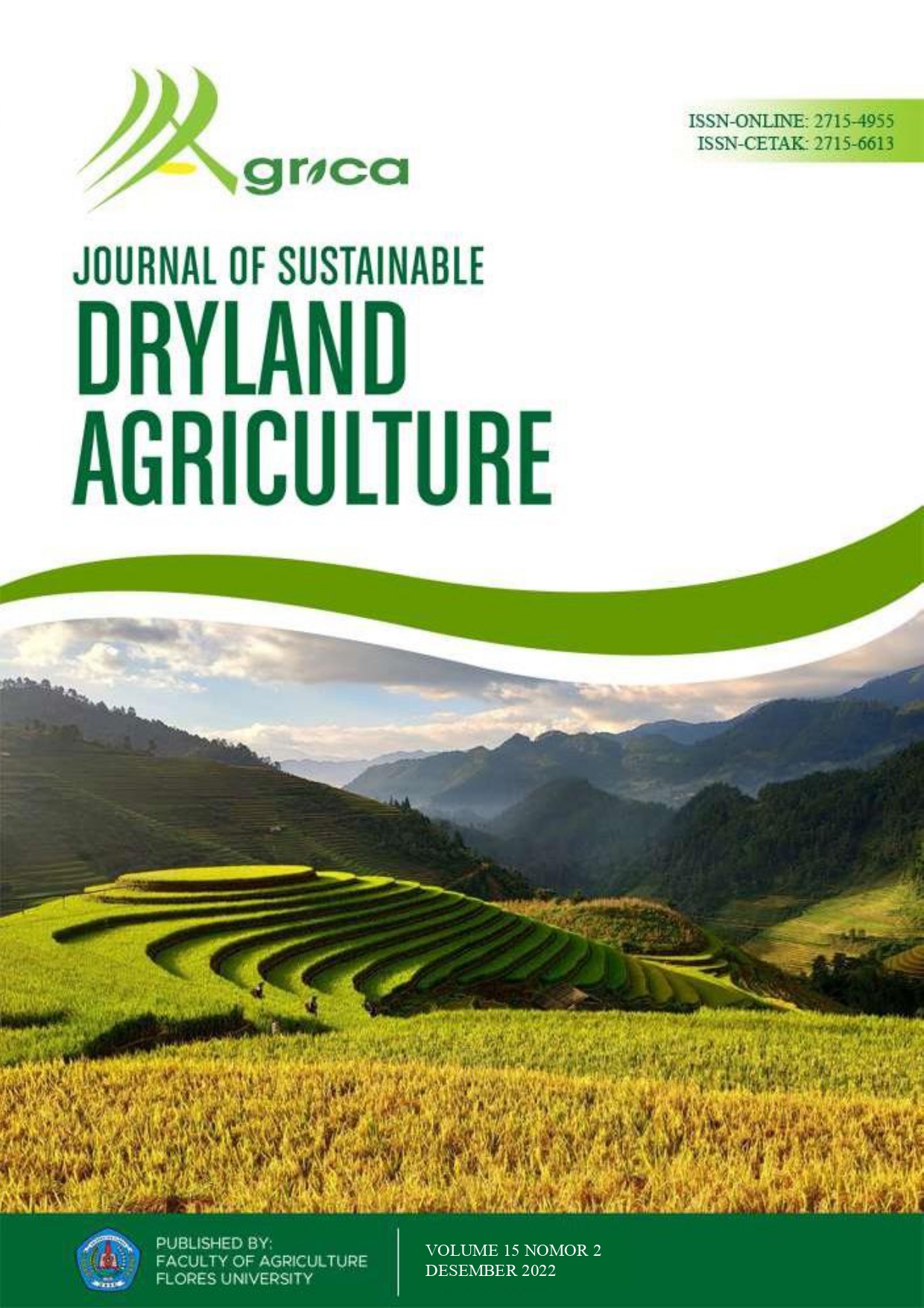RESPON TANAMAN JAGUNG PULUT (Zea mays ceratina Kulesh) AKIBAT BERBAGAI DOSIS PUPUK NPK PHONSKA DAN JARAK TANAM ANTAR BARIS
DOI:
https://doi.org/10.37478/agr.v15i2.2311Abstract
Waxi corn, which is included in the cereal plant group, is a food source for meeting the needs of life and has an important role in fulfilling community nutrition. Efforts to increase production that include quantity and quality can be made by applying NPK phonska fertilizer and spacing out planters to minimize the occurrence of competition. The study was to obtain the interaction caused by various doses of NPK phonska dose with different spacings on maize plants and to obtain the optimum dose of NPK phonska and ideal spacing to produce the optimum pulut maize plant. Using a factorial randomized block study design (RAKF)consisting of two treatment factors, each combination was repeated 3 times. Phoska NPK treatment consists of three levels (P1:50; P2:100 and P3:150)kg/ha, While the spacing treatment includes (J1: 50x 40; J2: 60x40 and J3: 70x40) cm. Data is collected non-descriptively. level F test5% to go to treatment. The interaction effect is based on Duncan's 5% test and LSD 5% test for a single treatment difference phonska test on the variable length of cropping cobs and yield hectare with a percentage increase of 15,19% and 28,33% respectively, the single treatment of plant spacing had a significant effect on the variable cob weight cropping weights 33,73%.
Downloads
Keywords:
Dosage, Phonska NPK, Planting Distance Waxi CornReferences
Badan Pusat Statistik Nasional. (2018). Statistik Pertanian (Pusat Data). 2018.
Bilman W. S. (2001). Analisis pertumbuhan tanaman jagung manis (Zea mays saccharata), pergeseran komposisi gulma pada beberapa jarak tanam. Jurnal Ilmu-Ilmu Pertanian Indonesia, 3(1), 25–30.
Bobi, S., Wahyudi, & Seprido. (2021). Pengaruh Waktu Aplikasi Pupuk NPK Phonska Terhadap Pertumbuhan Dan Produksi Jagung Pulut (zea mays ceratina L.). Jurnal Green Swarnadwipa, 10(1).
Fowo, K. Y., Suminarti, N. E., & Suryanto, A. (2019). Response of three waxy corn (Zea mays L. var. ceratina kulesh) varieties and various planting date of intercropped groundnut (arachis hypogaea L.) in dry field. International Journal of Plant Biology, 10(1), 31–34. https://doi.org/10.4081/pb.2019.7459
Gomez, K. A,. dan Gomez, A. A. (2007). Prosedur Stastistika Untuk Penelitian Pertanian. ( Terjemahan A. Sjamsuddin dan J. S. Baharsyah Edisi Kedua. Universitas Indonesia Press, Jakarta).
Herlina, N., & Aisyah, Y. (2018). Pengaruh Jarak Tanam Jagung Manis dan Varietas Kedelai terhadap Pertumbuhan dan Hasil Kedua Tanaman dalam Sistem Tanam Tumpangsari. Buletin Palawija, 16(1), 9. https://doi.org/10.21082/bulpa.v16n1.2018.p9-16
Ikwani, Pratiwi, G. R., Paturrohman, E., & Makarim, A. K. (2015). Peningkatan Produktivitas Padi Melalui Penerapan Jarak Tanam Jajar Legowo. Iptek Tanaman Pangan, 8(2), 72–79.
Jumini, Nurhayati, dan M. (2011). Efek Kombinasi Dosis Pupuk N P K Dan Cara Pemupukan Terhadap Pertumbuhan Dan Hasil Jagung Manis. J. Floratek, 6, 165–170.
Kartika T. (2018). Pengaruh Jarak Tanam terhadap Pertumbuhan dan Produksi Jagung (Zea Mays L) Non Hibrida di Lahan Balai Agro Teknologi Terpadu (ATP). Sainmatika: Jurnal Ilmiah Matematika Dan Ilmu Pengetahuan Alam, 15(2), 129–139. https://doi.org/10.31851/sainmatika.v15i2.2378
Khotimah, A. K., Hidayat, N., & Mahfud, M. C. (2018). Optimasi Komposisi Pupuk Tanaman Jagung Menggunakan Algoritme Genetika. Jurnal Pengembangan Teknologi Informasi Dan Ilmu Komputer (J-PTIIK) Universitas Brawijaya, 2(8), 2534–2541.
Marjoko Y. (2019). Memupuk Tanaman Jagung Yang Baik Dan Benar. 29 Desember 2019.
Mokhtarpour, H., Christopher, B. S., Saleh, G., Selamat, A. B., Asadi, M. E., & Kamkar, B. (2010). Non-destructive estimation of maize leaf area, fresh weight, and dry weight using leaf length and leaf width. Communications in Biometry and Crop Science, 5(1), 19–26.
Nai C.P dan Fowo K.Y. (2019). Respon Pertumbuhan DAN Hasil Tanaman Jagung Pulut (Zea mays ceratina Kulesh) pada Berbagai Jarak Tanam Dalam Baris. J.Agrica, 12(1), 59–70.
Sapto Nugroho, W. (2015). Penetapan Standar Warna Daun Sebagai Upaya Identifikasi Status Hara (N) Tanaman Jagung (Zea mays L.) pada Tanah Regosol. Planta Tropika: Journal of Agro Science, 3(1), 8–15. https://doi.org/10.18196/pt.2015.034.8-15
Saragih, D., Hamim, H., & Nurmauli, N. (2013). Pengaruh Dosis Dan Waktu Aplikasi Pupuk Urea Dalam Meningkatkan Pertumbuhan Dan Hasil Jagung (Zea mays, L.) Pionir 27. Jurnal Agrotek Tropika, 1(1), 50–54. https://doi.org/10.23960/jat.v1i1.1890
Shafi, M., Bakht, J., Ali, S., Khan, H., Khan, M. A., & Sharif, M. (2012). Effect of planting density on phenology, growth and yield of maize (Zea mays L.). Pakistan Journal of Botany, 44(2), 691–696.
Silaban, E.T, P. E. dan G. (2013). Pertumbuhan Dan Produksi Jagung Manis (Zea mays sacaratha Sturt. L) Pada Berbagai Jarak Tanam Dan Waktu Olah Tanah. J. Online Agroteknologi, 1(3), 806–818.
Suarni, & Muh. Yasin. (2016). Jagung sebagai Sumber Pangan Fungsional. Pangan Dan Pertanian, 5(6), 1–16.
Syafruddin, Padang, I. S., & Saidah. (2015). Perbaikan Pola Tanam Palawija pada Lahan Kering di Kabupaten Parigi Moutong Sulawesi Tengah. Jurnal Pengkajian Dan Pengembangan Teknologi Pertanian, 18(3), 263–272.
Tengah, J., Tumbelaka, S., & Toding, M. M. (2017). Pertumbuhan Dan Produksi Jagung Pulut Lokal (Zea mays ceratina Kulesh) pada Beberapa Dosis Pupuk NPK. Cocos, 1(1), 1–10.


















